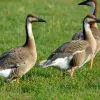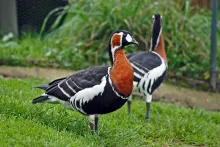
Red-breasted Goose (Branta ruficollis)
Species name
- Dutch name:
- Roodhalsgans
- English name:
- Red-breasted Goose
- German name:
- Rothalsgans
- French name:
- Bernache
- Scientific name:
- Branta ruficollis
Scientific classification
- Order:
- Anseriformes
- Family:
- Anatidae
- Onderfamilie:
- Anserinae
- Genus:
- Branta
Description
- Description:
Male:
Unmistakable red, black and white goose. The fore-neck, breast and sides of the head are chestnut red bordered with white White flank-stripe and black belly. White rear belly and black tail.. The wings, back and fore-belly are charcoal black, with a bright white stripe running down the side to the white rear belly. The short neck and dark belly stand out in flight, and when seen from above two crescent-shaped stripes are visible on each wing.Female:
Identical to Male but slightly smaller best if compared wile paired .Juvenile:
Generally duller than adult. Short neck and dark belly stand out in flight. Similar spp. Can be surprisingly difficult to detect amongst large flocks of other geese.
- Behaviour:
The Red-breasted Goose (Branta ruficollis) can take a little while to settle in, but with care and calm handling they are delightful in a mixed water fowl collection. In a few weeks they will become increasingly vocal. Favoured nest sites are amongst natural tussocks of grass. The gander will defend the site: there will be no ambiguity about his intentions to protect his family.
Standard Measurements
- Body Length (cm):
- The male (drake) of the Red-breasted Goose measures approximately 53-56 centimeters. The female measures approximately 53-56 centimeters.
- Body Weight (grams):
- The male will weight about 1225-1545 gram. The female will weight about 1225-1545 gram.
The weight is notoriously variable and can only be used as indication!
- Habitat:
For a single pair of geese a total pen area of 300m² (or 200m² for smaller species), with at least 20% of this area water is suggested, although more water should be provided if possible in a larger pen.
- Note:
Red-breasted geese are winter-hardy, easy to keep, very decorative, unaggressive and mix well with other species. Large enclosures with good grazing and clear cold water are preferred. Good grazing will provide most of their food, although floating pelletsd and greenfood should also be provided.
This species can be difficult to breed; good grazing area and good sized water area suggested to encourage breeding. They nest on the open in short grass, also less commonly under bushes, in huts or on islands. Eggs are laid mid June to July and may be parent-incubated, or if the risk of predation is high, a broody hen or incubator may be preferred, although parent rearing is advisable where possible. Breeding success may be decreased if these species are allowed to become too fat and this can be problematic particularly for the species which normally breed in the high Arctic.
These geese may pair with other geese species if no mate of their own species is available. Hybrids have been reported with Greater white-fronted goose (Anser albifrons) and Ross's goose (Anser rossii).
- Breeding:
- The female Red-breasted Goose usually lays from 3-10 eggs, most commonly 4-5 cream eggs and incubates them for 25-27 days.
- Artificial incubating:
The ideal relative humidity for incubating most waterfowl eggs is 55% (ground nesters) and 40% (cavity nesters). The temperature is usually 37.4°C. Set ventilation as recommended by the incubator manufacturer. Eggs must be turned, either automatically or by hand, a minimum of 4 times a day. As the duckling develops there is a loss of water from the egg and the air sac gets bigger. In normal development of an egg with a 25-27 days incubation, the air sac occupies about a third of it three days earlier. Cleanliness is vital and ideally eggs should be moved to a separate hatcher at this point, where the humidity should be increased to 65% and even higher once they have pipped internally.
- Bird banding:
- Recommended closed leg band ring size for the Red-breasted Goose is 12 mm.The leg band ring can only be applied on a young goose at around 12-14 days old.
- It doesn't matter what leg that you band, but it's good to have a consistent system. Suggested: Left leg = Female, Right leg = Male
- Maintenance food:
-





Lundi Regular with a protein content of 20%, valuable Spirulina and high-quality by-products is optimally balanced in its composition maintenance food for water ornamental fowl of all kinds. Especially green teal and Whistling ducks that are not dependent on a very high protein content, are well supplied.
Lundi Regular contains all the minerals and vitamins in full form that are important for the animals. Therefore also suitable as breeding food.
- Regulation:
- Vrijstelling CITES, bijlage X
- Regulation:
Vogelsoorten die zijn opgenomen in Bijlage X bij de Uitvoeringsverordening zijnvogelsoorten die zijn opgenomen in Bijlage A van de Basisverordening maarz?veel in gevangenschap worden gefokt dat er vrijwel geen wilde exemplarenmeer worden verhandeld.De wetgeving is hierover op het moment niet eensluidend en derhalve kunnen wij u hierover geen advies geven. Wij zijn in gesprek met de overheid om hierduidelijkheid in te krijgen.Ook hier geldt het advies: Ring altijd uw jonge vogels met een juiste pootring.Koopt u vogels van deze soort zonder pootring vraag dan altijd een herkomst of afstandsverklaring aan de verkoper.

